Excerpts from Jim Conrad's
Naturalist Newsletter
from the June 7, 2018 Newsletter issued from Rancho Regenesis in the woods ±4kms west of Ek Balam Ruins; elevation ~40m (~130 ft), N~20.876°, W~88.170°; central Yucatán, MÉXICO
GRASS SPIDER ON A FENCEPOST
Beside a rancho cowtrail through the woods, an old, decaying fencepost rose up through bushes and weeds. Atop the fencepost a spider's sheet web -- one of those horizontally deployed webs usually seen near the ground -- had been established among a clutter of stems and leaves. It was curious that a sheet web would be shoulder and not ankle high, and the spider was clearly visible waiting for prey to land on the web, so I took a look. The whole thing can be seen below:
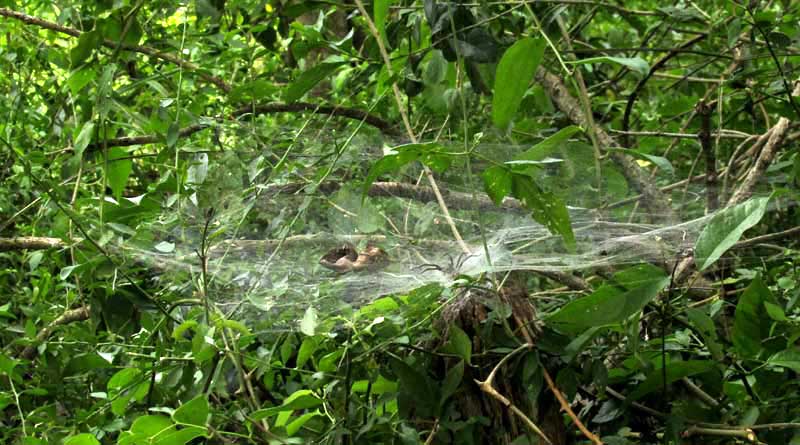
A close-up of the spider, with hind legs firmly planted on the shadowy shelter's walls, so that a quick retreat into the hole can be made if threatened, appears below:
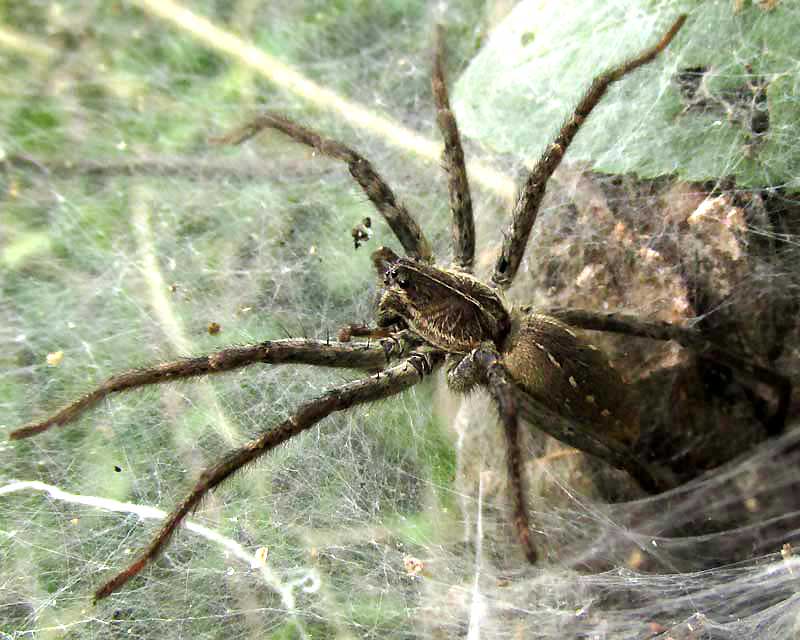
Below you have a better look at the head part, nicely showing some of the spider's eight eyes arranged in three rows, and the dark, sharp leg-bristles:
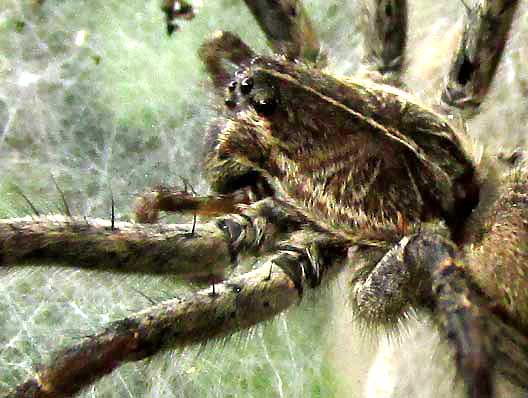
Trying to get even closer than I did for the last picture, the spider spooked and faster than my eyes could follow disappeared into her hole. It was an unusual place for a sheet web hole, but a very effective one, formed where the fencepost's heart had rotted away, shown below:
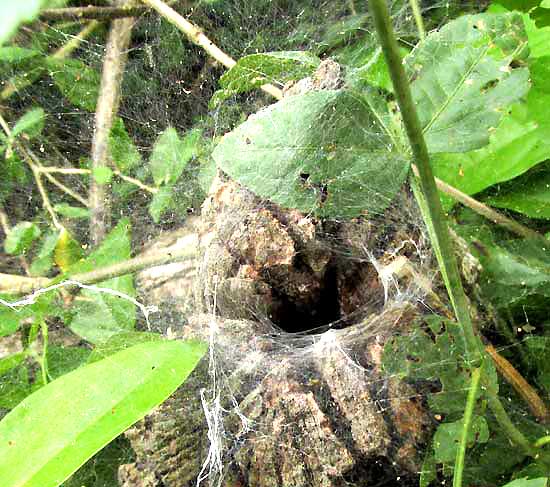
We've seen sheet-web-weaving spiders similar to this one, in the genus Agelenopsis. You might enjoy comparing the preset one with one seen in Mississippi, at www.backyardnature.net/n/a/grass-sp.htm
All species of Agelenopsis are known as American grass spiders, so that name is a general one. However, it's the only name I can give here, for -- at least in the Yucatan -- identification to species level is too hard.
Grass spider sheet webs are not sticky. They're just highly visible platforms that certain flying invertebrates might think would be a nice place to land, and when something does appear on the sheet, the spider runs very rapidly onto the sheet, grabs the prey, and bites. Grass spider bites aren't venomous enough to bother humans, but they cause rapid paralysis in insects.
Wikipedia's page on American Grass Spiders lists 13 Agelenopsis species, of which only one is mentioned as occurring in Mexico. That's Agelenopsis aperta, the Desert Grass Spider, but pictures of that species don't match our fencepost sitter. The pale lines on our spider's front part, the cephalothorax, are thinner. So, maybe this is a Yucatan variation, or a different species, maybe even a species unknown to science, since little work has been done on the Yucatan's spiders.
Here we'll file these pictures under Agelenopsis and trust that eventually someone will be glad to see them, and know that this taxon with slender lines on the cephalothorax are found here.
from the June 29, 2019 Newsletter issued from near Tepakán, north-central Yucatán state; elevation ~9m (~30 ft), N21.053°, W89.052°; MÉXICO
GRASS SPIDER IN A STONE WALL
A grass spider has taken up residence in a chink in the stone wall of the hut I live in, as you can see in the center of the picture below:
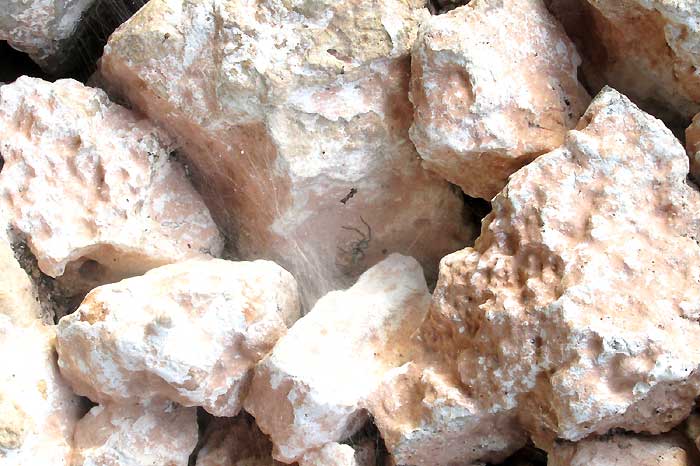
Most of the time the spider hides within the web tunnel's darkness, but whenever I slap a horsefly biting my legs and the fly is only dazed, I pick it up and thump it toward the tunnel, the spider rushes out, and sinks fangs into it, as shown below:
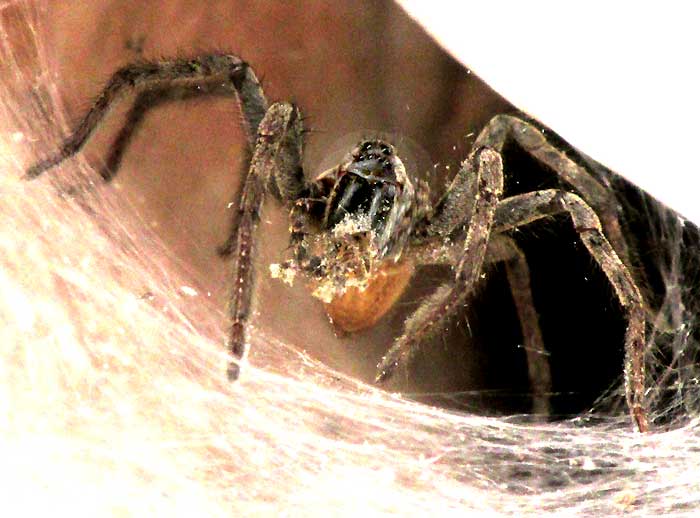
The spider seems to be the same species profiled above, as you can confirm in the picture below, with the lines and spots on the spider's top side plainly visible:
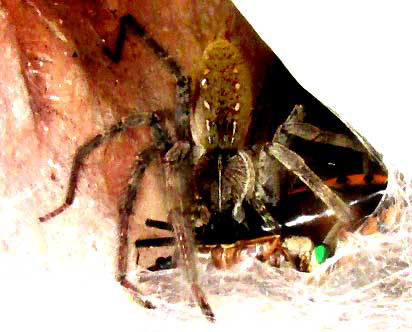
I'm still undertain of this spider's ID, but at least now it's clear that the species may be common in the northern Yucatan. Also, it's worth noting that both times the species has been observed the web was constructed at about the same height, some 1.5m high (5ft), and neither time was the web in grass